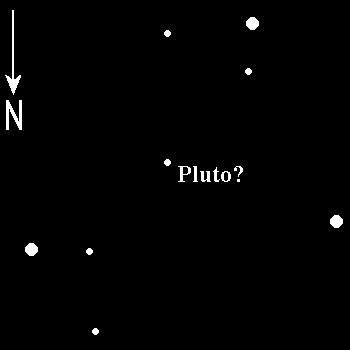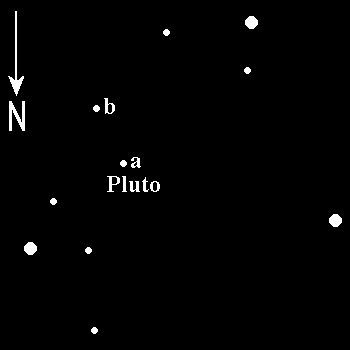 Figure 1. Star field on 03 May.
Figure 1. Star field on 03 May.
 Figure 2. Star field on 05 May.
Figure 2. Star field on 05 May.
Orwell Astronomical Society (Ipswich)
Tour Of The Solar System In One Evening, 04 May 1989
In early May 1989, Mercury reached greatest eastern elongation, setting shortly after the Sun, and Venus was visible in the evening sky setting approximately 30 minutes after sunset. The outer planets were all some distance from the Sun in the sky and Pluto was near opposition. Amazingly, the weather was fine and I thought that it would be an interesting challenge to attempt to observe all the planets1 in one evening.
I made my first attempt on Wednesday 03 May at Orwell Park Observatory. My first major difficulty was finding Venus, as it was very low down and close to the Sun. We had found Mercury readily at Orwell Park on the previous Wednesday, 26 April, when Martin Cook was first to see it, finding it without optical aid before several others searching with binoculars! Martin's success with Mercury the previous week spurred me to search the western sky for Venus - but in vain. There was some cloud near the horizon which may have obscured the planet. Although failing to find Venus, I did however manage to find Mercury again quite easily.
Later in the evening, I observed Jupiter and Mars and began searching for Pluto. Using the Orwell Park 26 cm refractor, I was able to locate many of the stars in the finder chart given in the BAA handbook and could make out a faint point of light in the position predicted for Pluto. Interestingly, although I could make out the object which I thought to be Pluto, slight haze and light pollution from Felixstowe Docks prevented me from seeing several of the background stars in the finder chart. I sketched figure 1 below to show the star field that I could see. The sure way of confirming a sighting of Pluto is to observe it on successive evenings and to note its movement against the background stars. Without achieving a sighting of Venus on 03 May, the incentive to stay up and observe the remaining planets waned and I decided to retire at this point, hoping to observe again in a day or so, when I would, I hoped, be able to confirm the identity of Pluto and find also the other planets.
The sky was clearer on the evening of Thursday 04 May than it was on the previous day, with a cloudless view down to the horizon. I could not waste such a clear evening! At about 7.30pm I started searching for Venus from home with 11x80 binoculars. After 15 minutes without success I was beginning to feel that my luck was out. I went indoors and used my favourite ephemeris program on my PC to check the position of Venus and found that it was at an altitude of a mere 7.5°. Rushing outdoors once more with camera tripod in hand, I set up the binoculars on the tripod as quickly and accurately as possible (two totally incompatible objectives, of course!) and scanned the treetops (also lying at 7.5° altitude) in the west. My luck had changed! There was Venus shining brightly just above the treetops. It looked bright enough to be visible to the naked eye, but even knowing exactly where to look I could not see it without optical aid. I found Venus at 8.05pm and it disappeared behind the treetops at 8.20pm, so I had been fortunate indeed.
Having found Venus, the next challenge was to find the remaining planets and to verify Pluto by noting its movement from the previous evening. I first searched for Jupiter and Mercury. At 8.30pm I found Jupiter. With the binoculars mounted on the tripod I could discern the disk but could not see any moons. Having found Jupiter, I next looked for Mercury, and some twenty minutes later, there it was shining clearly in the binoculars. I should explain that I could not observe Venus, Mercury or Jupiter with my 25 cm reflector because the trees that almost obscured my view of Venus earlier in the evening completely obscured the three planets.
After such initial success, I decided to wait until the sky darkened before continuing. At 10.50pm I observed Mars with my 25 cm reflector. Using 200x magnification I could make out a small gibbous disk but could not discern any surface features. Next on the list was Pluto, however I had to wait for the sky to darken and also for Pluto to clear a neighbour's tree before I could start the search. I spent half an hour or so killing time by leisurely scanning Virgo for some of the brighter galaxies and, at 11.30pm, began the search for Pluto. I quickly found the star fields that I had seen on the previous evening. With a darker observing site than Orwell Park, and possibly a more transparent sky, I could see several more stars in the field than I had on the previous evening. The faint object that I had observed the previous night and though to be Pluto had moved, confirming its identity. I drew the star field shown below in figure 2 at 00.10am on 05 May; point "a" is Pluto. I must admit that when I made the drawing, I was convinced that "b" rather than "a" was Pluto. I was recalling the previous evening's star field from memory, and the difficulty of doing so was compounded by the fact that neither "a" nor "b" had then been visible. I thought that the path of Pluto was further south than in reality was the case and concluded that "a" was a background star, shown on the BAA star field, that was now visible and "b" was Pluto. In fact, it was on the following Wednesday, 10 May, at Orwell Park that I recognised my mistake. The photographic finder chart for Pluto published in "Astronomy" magazine revealed that "b" was, in fact, a faint double star, "a" was Pluto, and the background star shown in the BAA finder chart had not been visible: a simple case of mistaken identity. In retrospect, it was a silly mistake that I should have spotted immediately. Interestingly, in my observing log for the night I had scribbled a note to the effect that "b" was noticeably fainter than "a", and I remember thinking at the time that this was strange and wondering if perhaps Charon was eclipsing Pluto, resulting in a drop in its magnitude.
So, on the night of 04 May, I did observe and record Pluto even though at the time I associated it with the wrong point of light! That only left observation of Saturn, Uranus and Neptune to complete the set. I found Uranus in the binoculars at 1.35am but, because of the neighbour's tree could not positively confirm its identity with the 25 cm reflector until 2.07am. In the 25 cm reflector using magnifications of 150x and 200x I could see a small, featureless somewhat fuzzy disk (the low altitude contributed to the fuzz). I saw Saturn at 1.45am with the binoculars; again because of the neighbour's tree it was 2.00am before I could observe it with the 25 cm reflector. Although Saturn was almost on the horizon, I could see the rings clearly with very little shimmering and I could discern Cassini's division - unprecedented seeing conditions! Finally, at 2.30am I found Neptune with the 25 cm reflector. (I had been unable to find it with the binoculars because of atmospheric extinction associated with its low altitude.) However, at a magnification of 280x in the 25 cm reflector, I could discern a small fuzzy disk that appeared marginally larger than the nearby stars of similar magnitude.
I'm sure that I'm not the first observer to see all nine planets in one night, but I found it to be a difficult and thoroughly rewarding observing challenge.
 Figure 1. Star field on 03 May.
Figure 1. Star field on 03 May.
 Figure 2. Star field on 05 May.
Figure 2. Star field on 05 May.
[1]
At the time of the observations, the solar system was understood to contain nine planets: Mercury, Venus, Earth, Mars, Jupiter, Saturn, Uranus, Neptune and Pluto. On 24 August 2006, the IAU redefined the term planet in a way which excluded Pluto and reclassified the latter as a dwarf planet 134340 Pluto.
David Payne